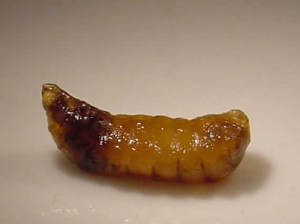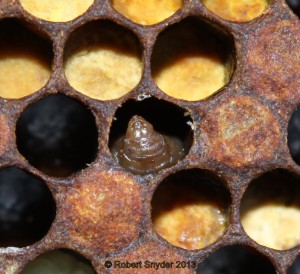Sacbrood Virus (SBV)
Morator aetatulas
Description
Found worldwide, sacbrood virus is easily recognizable for the fluid-filled sacs that infected larvae eventually become. While not a source of major concern for beekeepers, sacbrood virus can none-the-less be a nuisance for colonies coming out of winter and into spring.
Etiology
Sacbrood is caused by a virus that is transferred from adult honey bees to young larvae. Larvae are most susceptible at 2 days old and are infected through the glandular secretions of infected nurse bees.
Infected larvae begin to turn from white to yellow and fail to pupate. They are unable to shed their leathery endocuticle, under which fluid begins to accumulate. They form a sac-like appearance that is characteristic of this disease. Larvae die in the upright position and eventually turn dark brown and desiccate.
While the virus within the dead larvae quickly loses its virulence, it is perpetuated in adult bees.
Newly emerged adult bees are first tasked with cell cleaning duties. It is during this activity that the adult bees are often infected. While removing dead sacbrood from cells, they inadvertently ingest the virus-rich fluid that accumulated under the dead larva’s skin and become infected themselves. While symptoms of disease are less detectable in adult bees, they often begin foraging much sooner and have shorten lifespans.
Spread and Control
Sacbrood is most commonly seen during the spring and early summer, but will often clear up on its own during a good nectar flow. There are no chemical controls on the market for use against sacbrood, however, the best method for prevention is to maintain strong, healthy colonies. Requeening may also be effective.



